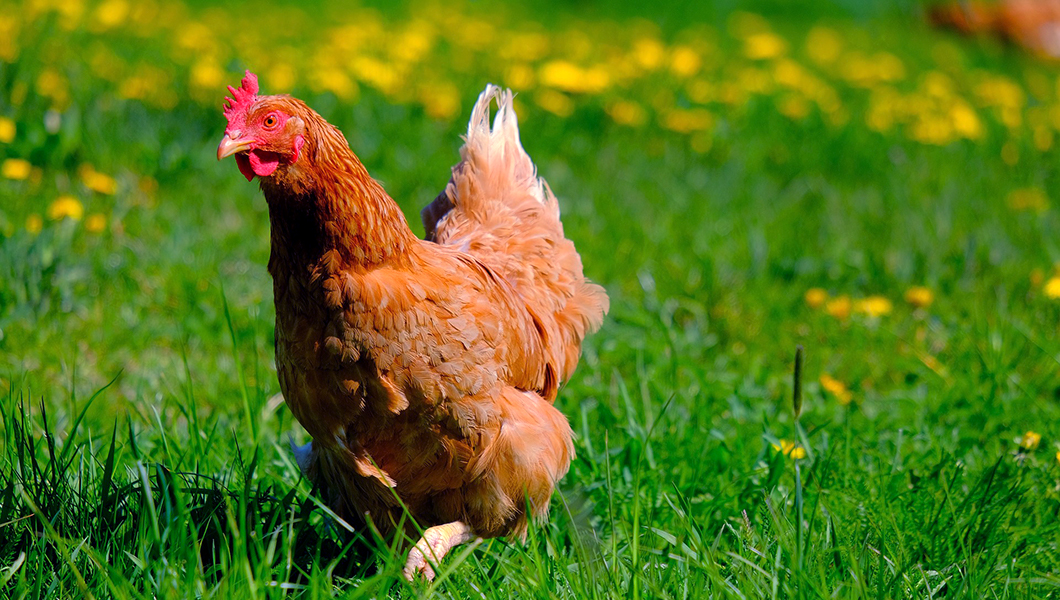Soil Health
in Integrated Crop-Livestock Systems
Livestock provided the primary source of soil fertility for many thousands of years up until the green revolution brought about synthetic alternatives. While those fossil fuel farm inputs are often still cheaper and easier to implement at an industrial scale, the externalized costs and downstream pollution are increasingly unacceptable. Re-establishing integrated cropping systems is an essential step towards regenerative agriculture.
Integrated crop-livestock systems (ICLS) are well-recognized for their invaluable role in productive, resilient, and sustainable agriculture. However, these systems are often poorly managed due to overgrazing, soil compaction, erosion, pathogen contamination, and crop damage. Maintaining crop and soil health while also considering the wellbeing of livestock can be challenging without appropriate knowledge and tools. When well-managed, ICLS can feed the soil food web, boost crop production, and increase both water retention and carbon sequestration. Consider the two meter-thick, rich black soils of historic American grasslands, built up through the grazing and trampling of massive, predator-driven bison herds (Knapp, 1999). In contrast, the precarious condition of soils in the present-day American West was largely caused by a century of continually-grazed sheep and cattle and worsened by fire suppression, habitat fragmentation, and introduced species (Ceballos, 2010).
Integrated Livestock Effects on Soil
- Improve soil fertility:
- Add nitrogen, phosphorus, potassium
- Add micronutrients essential for plant growth
- Increase soil organic matter (SOM) through:
- Manure
- Trampling
- Root dieoff
- Increased biomass production
- Benefits of higher SOM include:
- Feeding the soil food web, making nutrients become bioavailable to plants,
- Reducing the prevalence of crop disease
- Increasing water-holding capacity, conservation, and drought resistance
- Increasing soil carbon sequestration
- Reducing erosion and compaction
- Soil fertility directly correlates with production and profits
Research Summary
The primary takeaway from our research project is that livestock manure can provide
a cost-effective replacement for conventional fertilizer in orchard and vineyard systems.
Livestock manure does not add as much organic matter as compost, but generally can
provide comparable nitrogen, phosphorus, and potassium as most fertilizer programs
if animals are stocked at a high enough rate. Because soil properties are highly variable,
manure may be inadequate to maintain optimal health and productivity in your unique
system. Soil testing along with ongoing adjustments and amendments can ensure .
Field research began in the spring of 2019, providing the first year of data exploring
the impacts of integrated livestock on soil health, weed and pest pressure, crop production,
and food safety within orchard production systems. We replicated the study with three
batches of broiler chickens within three distinct orchard systems: a mature dessert
apple orchard (grazed in the late spring), a mature cider apple orchard (grazed in
the early fall), and a high-density cider apple orchard grazed in mid-summer.
All three of the orchard systems used in our study had soils low in macronutrients. Study areas were broken into randomized plots assigned to poultry, conventional fertilizer, or compost treatments. Poultry were stocked each year to match their expected nitrogen output with the amount of additional nitrate needed for optimal apple tree growth. This stocking rate was slightly different for each system but averaged 1 broiler per 35 square feet for seven days (1250 broilers/acre/week). Soil was measured each spring to track changes.
In areas with poultry, nitrate increased at higher rates than expected, phosphorus added was slightly lower, and potassium was almost equivalent to fertilizer. Compost performed better than fertilizer or poultry in terms of increasing soil organic matter and adding phosphorus. Tree growth (height and trunk width) did not show any significant differences from one treatment to the next, suggesting both poultry and compost treatments were meeting tree nutritional needs just as well as fertilizer.
2019 Research Results
Desired soil values for apple orchards:
| Soil Nutrient | Desired Ranges | Unit |
| Nitrogen | 0.04-0.06 | #/tree |
| Phosphorous | 12-20 | ppm |
| Potassium | 120-150 | ppm |
| Organic Matter | >2 | % |
| pH | 6-7.5 | pH |
| Magnesium | 100-150 | ppm |
| Calcium | 1000-5000 | ppm |
Nitrate results for all 3 study orchards after year 1:
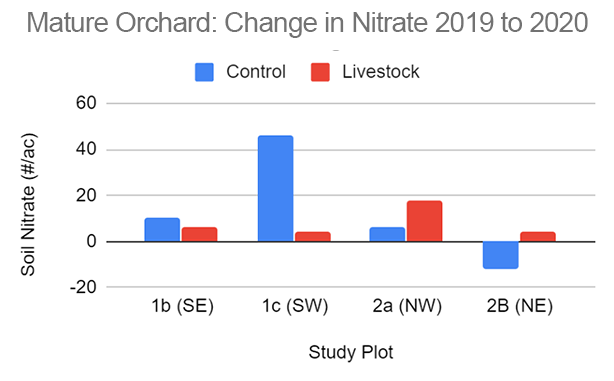
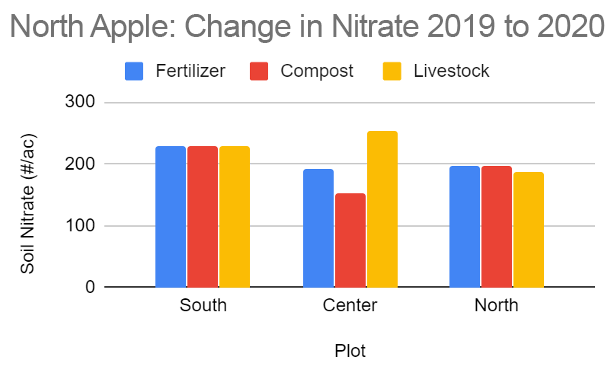

Phosphorous results for all 3 study orchards after year 1:
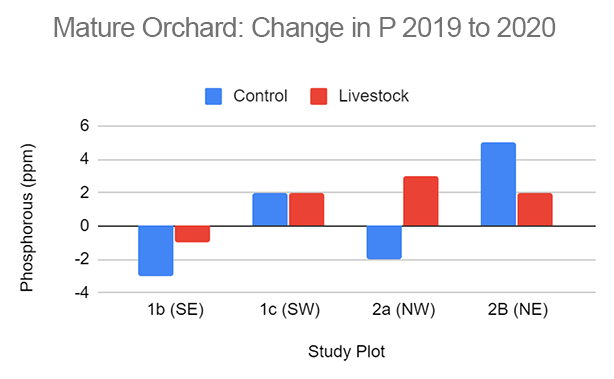
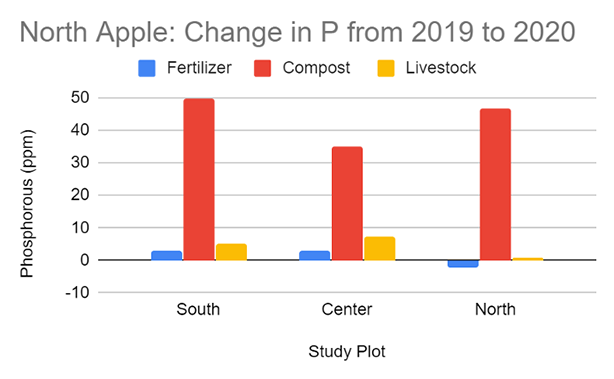
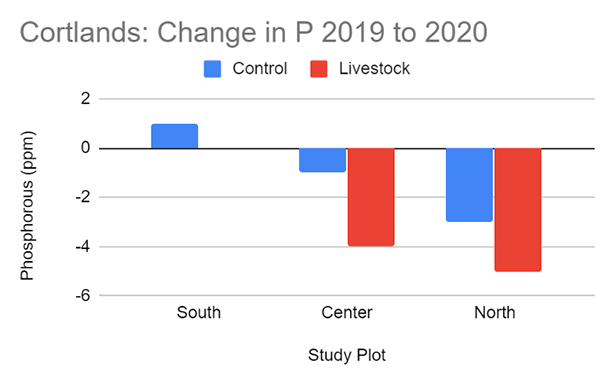
Potassium results for all 3 study orchards after year 1:


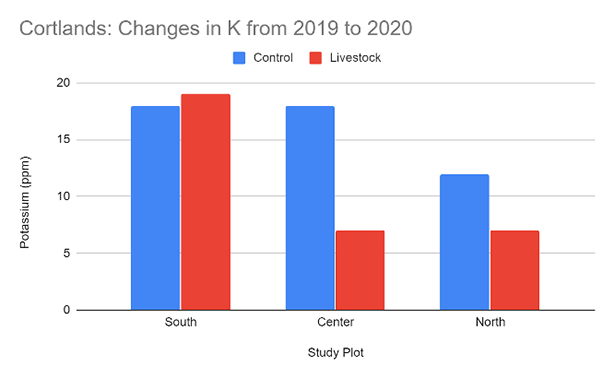
Soil Organic Matter results for all 3 study orchards after year 1:
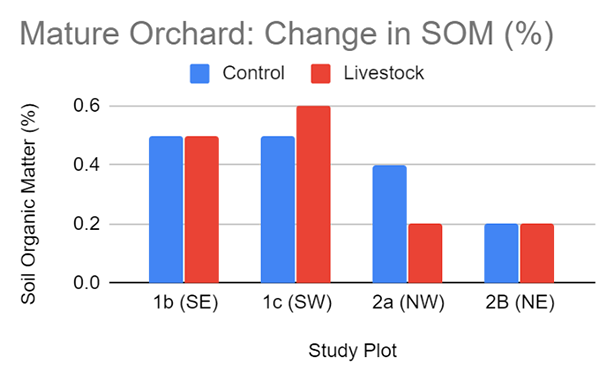


References
Ceballos, Gerardo, Ana Davidson, Rurik List, Jesús Pacheco, Patricia Manzano-Fischer, Georgina Santos-Barrera, Juan Cruzado, and Dennis Marinus Hansen. "Rapid Decline of a Grassland System and Its Ecological and Conservation Implications (Rapid Decline of Grassland)." PLoS ONE, 5.1 (2010): E8562.
Chantos, K., Swingley, Wesley D., Barber, Nicholas, & Jones, Holly. (2017). Microbial Community Dynamics in Tallgrass Prairie Soil Affected by Native Grazer Feces (Bison bison), ProQuest Dissertations and Theses.
Collins, Knapp, Riggs, Blair, and Steinauer. "Modulation of Diversity by Grazing and Mowing in Native Tallgrass Prairie." Science (New York, N.Y.), 280.5364 (1998): 745-47.
Knapp, Blair, Briggs, Collins, Hartnett, Johnson, and Towne. "The Keystone Role of Bison in North American Tallgrass Prairie - Bison Increase Habitat Heterogeneity and Alter a Broad Array of Plant, Community, and Ecosystem Processes." Bioscience, 49.1 (1999): 39-50.
Ryschawy, J., et al. "Integrated Crop-Livestock Management Effects on Soil Quality Dynamics in a Semiarid Region: A Typology of Soil Change Over Time." Applied and Environmental Soil Science, vol. 2017, 2017. Gale Academic OneFile. Accessed 26 May 2020.

